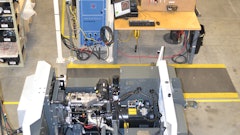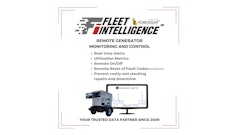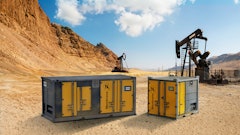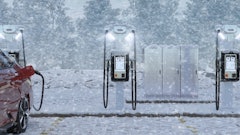
As construction equipment manufacturers continue to innovate the construction industry, the source of power and recharging the tools and equipment (both light and heavy) will be crucial to the jobsite. These sources of power always have been, but now changing market needs and policies are having their effect on the manufacturing and rental market.
“Overall, the market continues to demand increasingly high volumes of power both on grid and off,” says Ben Froland, product manager of power generation at Hatz Americas. “Emerging technologies such as efficient solar and improved lithium batteries present great opportunities to organically complement existing solutions like clean coal powerplants and low emissions diesel-powered mobile generators.”
Construction customers are now having to pay more attention to their environmental impact. “Companies are now required to report on the ESG (Environmental, Social, and Governance) scores of their portfolio companies and carbon emissions,” says Madison McCormick, marketing manager at ANA Inc. ![Smart Loa 6088407a6f7c0[1]](https://img.forconstructionpros.com/files/base/acbm/fcp/image/2024/04/16x9/smart_loa.6088407a6f7c0_1_.662ab2482f678.png?auto=format%2Ccompress&fit=max&q=70&w=400) ANA Inc.
ANA Inc.
As companies actively seek more sustainable solutions like hybrid energy systems or solar options, Anne Nelson, director of marketing for Powr2 sees a growing push toward green initiatives in the rental industry. Adding that generators and energy storage systems will likely play even more of a pivotal role in a rental company’s fleet, having a fleet of sustainable rental equipment unlocks new revenue streams and growth opportunities by tackling a wider range of customer challenges.
In the past, explains McCormick, changes in the industry have been driven by technology and cost. The emphasis has shifted toward sustainability with more focus now on reducing the carbon footprint of operations and improving efficiency. This shift will require investment not only in the technology and the supporting infrastructure but a shift in mindset and culture.
While this emphasis on green initiatives isn’t new for 2024, the drive continues. However, Froland notes that the approaches have scaled back from the “flashy and radical” concepts of pure battery applications to more pragmatic solutions like hybridization and traditional movers like diesel.
As the industry addresses needs, Erin Brown, product manager at Doosan Bobcat, recommends that rental business owners and fleet managers alike should understand several key aspects of modern portable generators to ensure efficient operation and customer satisfaction: power output and capacity, fuel type and efficiency, noise levels, portability and mobility, and maintenance requirements. Adding to that, Brown suggests that rental houses should understand the unique features and benefits of their generator lineup.
Diesel is still the dominant fuel source for general rental. Despite the requirements to move forward with green initiatives, the transition to sustainable practices can be tough for power generation industry players. Any stakeholders who aren’t fully convinced of the benefits behind sustainability efforts will likely be reluctant to change any established processes.
It’s hard to beat the return on investment of a solid, diesel generator, notes Froland. He adds, “Modern diesel generators are very clean and reliable, and they should be considered as part of a practical, green fleet. The last round of emissions (Tier 4 Final) reduced NOx and particulate emissions by 90%. Diesel generators powered by engines up to 74hp are simple and reliable with no SCR (selective catalytic reduction) and no DPF (diesel particulate filter).”
Meanwhile, hybrid solutions pairing a mobile energy storage unit to a generator are staking claim to their own space within the power generation arena. McCormick forecasts that energy storage and hybrid systems will have the highest growth in the power generation industry.
“We are transitioning away from a traditional industry where you have a power generation that comes from a traditional diesel or other gas generator,” says Alex Meek, co-founder and president at Moxion Power Co. “Our products and our commitment is rethinking how that energy and power is delivered to customers in a different, more efficient way.”
Nelson explains that the adoption of hybrid energy systems is being driven by factors such as regulatory requirements and pressure to reduce CO2 emissions—equipment rental companies are seeing the value in integrating these solutions into their fleets. However, hybrid energy systems tend to have a higher upfront cost. Recognizing this and that many of the rental industry are still catching up with the newest technological developments, McCormick recommends looking at the long-term to find the cost savings. She’s optimistic. “Hybrid energy systems can revolutionize the rental industry by providing a more sustainable and cost-effective power solution,” says McCormick.
Considering current emission standards, she says that Tier4 Final engines are a challenge for light and variable loads resulting in service and possible dependability issues. While a Loadbank may help address these issues on-site, this may burn additional fuel. “A proper hybrid system,” adds McCormick, “can solve these issues with the added benefits of reducing emission, reduced fuel use, less maintenance, reduced generator run time, and with a higher level of dependability.”
Both Nelson and Froland state that battery energy storage solutions (BESS) have gained traction within today’s rental fleets. The primary application, explains Nelson, “is often the optimization of diesel generator usage to drastically reduce generator runtime, reduce fuel costs, and cut CO2 emissions.” She looks back at ARA 2024 where there were several more BESS manufacturers on the floor as compared to the pre-pandemic years.
“What we’re really seeing is the initial pull into adopting electric construction equipment and in our instance, mobile energy storage.,” says Meek. “You have very large customers that have very aggressive carbon emissions reduction goals. They look to their general contractors saying, ‘how can we bring in new technologies to reduce [carbon emissions].’ Once you start getting into the equipment side, you quickly get to generators as being a primary contributor to the emissions profile. That has really sparked the demand. The GCs are turning around to the rental companies and saying, ‘We’re looking for this.’ Rental companies that are adopting it are able to have an edge.
“Their ability to win business, as a result of during an RFI over a bid, they can provide what is electrified or green equipment. We have found that—with a lot of the activity here but also across the country, those very large GCs are those big early adopters where there’s a lot of success happening.”
“Customers are specifically asking for BESS,” adds Nelson. “End-user demand is driving adoption. We increasingly find individuals and teams within client organizations devoted to sustainability, as indicated by titles like Sustainability Manager or ESG Team. These stakeholders are eager for effective means to lessen the organization’s environmental footprint. This conscientious transformation extends far beyond construction. Large-scale events, from music festivals to international sporting competitions, are increasingly adopting sustainability policies and innovative solutions.”

























